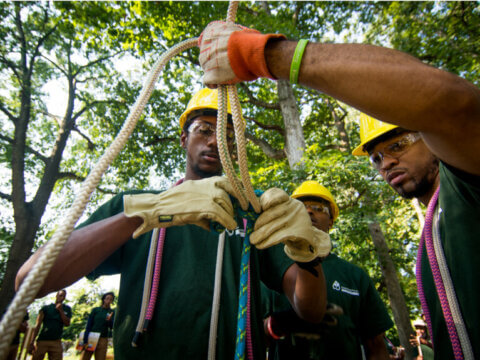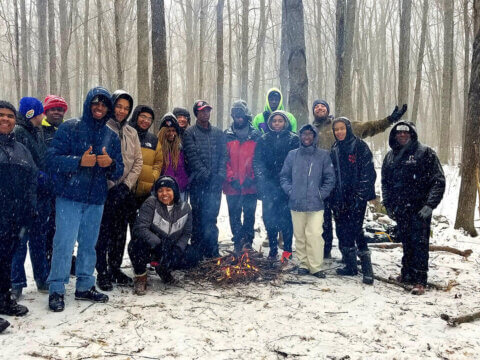Juneteenth, belonging and joy: A Q&A with Rue Mapp, Outdoor Afro’s founder
If you have the opportunity to talk with Rue Mapp, one of the first things you’ll notice is how often — and how naturally — she frames the conversation with words like celebration, connection, belonging and joy. Mapp is an author, outdoor fashion designer, and the founder and CEO of Outdoor Afro, a not-for-profit organization that celebrates and inspires Black connections and leadership in nature. When she talks about the organization, it’s as if she’s gently challenging the listener to reframe their own mindset away from deficits and instead recognize and, yes, celebrate how much progress has been made.
Mapp initially launched Outdoor Afro as a blog in 2009, aiming to shift the visual representation and narrative of Black people in nature. Fifteen years later, she’s built Outdoor Afro into a volunteer-led network of more than 60,000 community participants in 60 cities across the United States. The organization annually provides outdoor leadership training for more than 100 volunteers, who then go on to guide 1,200-plus nature adventures in their communities, from foraging to skiing, and kayaking to gardening.
Here, Mapp tells us about that journey. Along the way, she explores the concepts of representation, community and belonging, the meaning of Juneteenth, and how nature can connect us all to joy.
Let’s start with how you came to this work.
It was really organic, in that it was more of an amplification of what I’d grown up with in a family where there is a strong tradition of connecting to nature. And for me, what was special about [that tradition] was obviously a Black family, and a Black family that had migrated from the South and created for themselves a hobby ranch about 100 miles north of where we lived in Oakland, California.
Tell us about those early experiences in nature — what was it like growing up in Oakland and on the ranch in Northern California?
In the Oakland Hills, I was surrounded by the redwoods — there were trails and lots of green spaces to explore. But at the ranch, it was the rolling woodland biome of California that was able to be farmed with livestock. My dad was very much an outdoorsman who hunted and fished, and we had all of the things that you would want in order to explore every aspect of outdoor recreation, including a boat and a garden.
He was also a builder, so he was always working with his hands and creating structures. I had a swing set, and he built a tennis court, eventually. He was very much about creating space for not only himself but for other people to enjoy, and that space became a magnet for people in our family and the community at large for all kinds of togetherness and activities. So that was the blueprint given to me. It was also, for me, very important to experience the celebratory aspects of it, the spiritual and cultural roots of it.
I’m always interested in paths — how did these experiences lead you to founding Outdoor Afro?
As I was growing up, I was excited to pursue many connections to nature. I was into Girl Scouts and various activities that aligned with affinity groups and outdoor exploration. But then as I got older and wanted to do more things in the backcountry, or with other organizations that would meet me at my young adulthood, I found fewer people who looked like me, who shared the cultural experiences I’d had. And the way that it was framed for me in those contexts was very deficit-informed and, really, about the stereotypes that Black people don’t do certain things and we don’t have a relationship with the outdoors. I was working through that for several years. As a young mother, I created opportunities for my own family, like Family Camp with the City of Oakland and other activities, but there was always something missing — I just felt like more of an exception in those spaces.
So there was a moment of clarity in my own life about what was important to me. I was already using technology as a tool to find and create opportunities to go outside, and Outdoor Afro was born out of that; it was basically a blog that I put together in 2009.
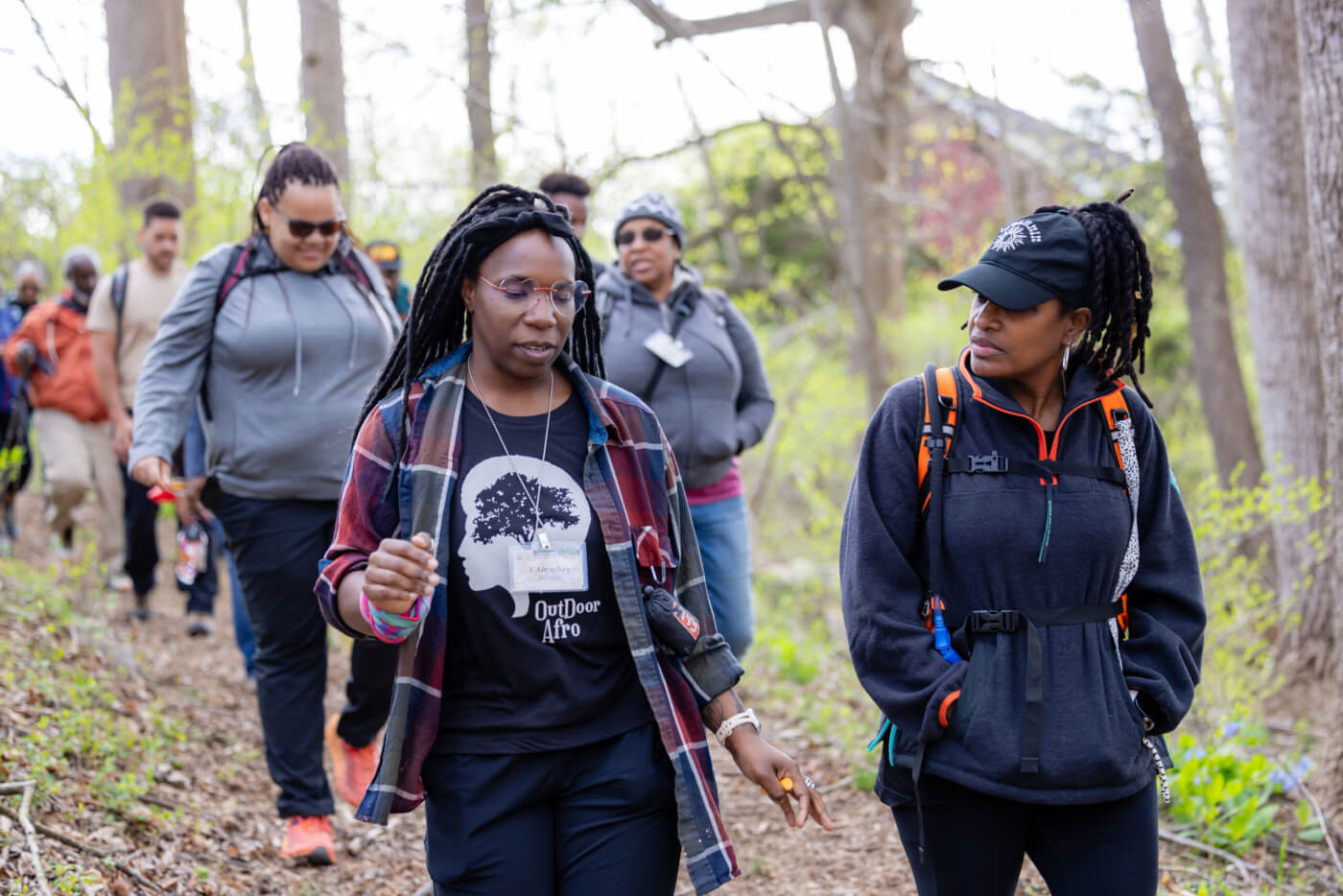
Outdoor Afro’s 2024 cohort of volunteer leaders at the organization’s annual Outdoor Afro Leadership Training held at the U.S. Fish and Wildlife Service’s National Conservation Training Center in West Virginia. Photo courtesy of Outdoor Afro.
What were you writing about on the Outdoor Afro blog — and what was the response from your readers?
I was talking about my story, about growing up in a family that loved nature, but I was also talking about the Black history and Black presence in the outdoors that was all around us, hiding in plain sight. So I wasn’t talking about being outdoors from a pioneering standpoint, but as something that we were already doing — and I found that reflected back to me in people saying, ‘That’s my story too,’ or ‘Here’s someone you should know,’ or ‘Here’s a story from our history.’ And so, I then began collecting and amplifying more stories about belonging and history and nature that were rooted in a narrative of Black people in the outdoors as strong, beautiful and free — and with the agency to continue being just that, not rescued, not unknowing, not lost. And as a part of the connection that all families have to nature in a very everyday way — especially thinking about how many people were raised on grandma’s garden or going fishing with uncles.
So there were people who just felt incredibly excited, and I got really beautiful responses. I remember one woman, she was like, ‘I think you made this blog just for me.’ And you know, that feeling has persisted. People feel a very strong sense of connection and ownership in the message and community of Outdoor Afro. And for me, there’s a recognition that when you put all the ‘only ones’ together, we’re actually quite numerous.
At what point did you realize that the Outdoor Afro blog was actually an organization — something that you could do for a living?
There were these big moments that happened, like getting invited to the White House. The Office of Youth under the then Secretary of the Interior discovered the Outdoor Afro blog and invited me to be a part of the signing of President Obama’s America’s Great Outdoors Initiative. That really raised my awareness of this new frontier of professional opportunity. And then there were parallel tracks, like participating in Children & Nature Network conferences as an advisor and working with conservation organizations and foundations that helped youth get outside.
Bit by bit, I was learning while building Outdoor Afro into an organization, and in 2012, I just stepped entirely into making it what I did for a living. Outdoor Afro grew from the blog and a small group of volunteers who’d join me to create meetups, to the national organization it is today. We now have a network of 100 volunteer leaders who activate a network of about 60,000 people of all ages to do all kinds of outdoor recreation in 30 states and 60 cities.
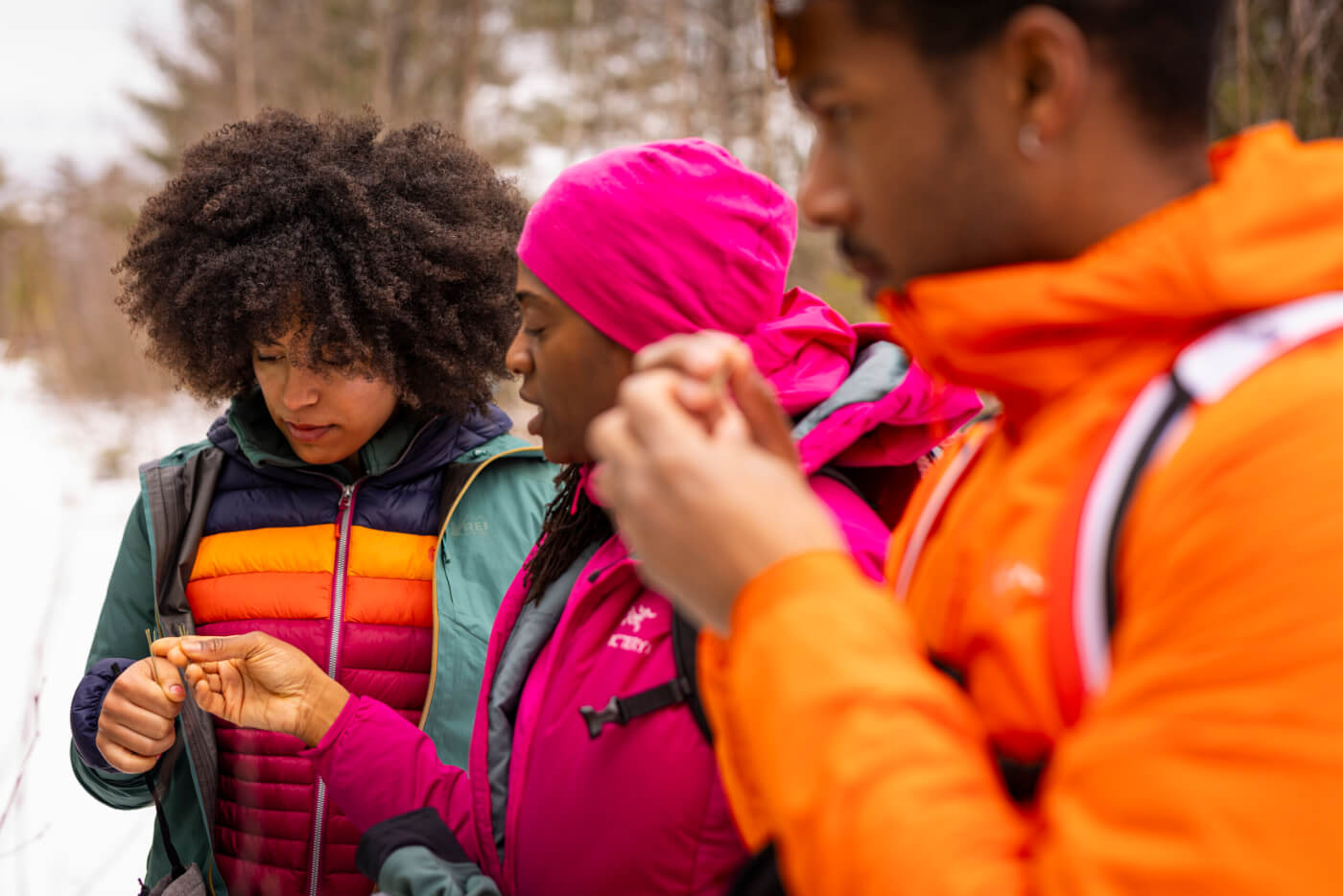
Outdoor Afro’s Boston network participants experiencing an animal tracking activity at Upper Saco Valley Land Trust in Conway, New Hampshire. Photo courtesy of Outdoor Afro.
In your book, “Nature Swagger,” you talk about welcoming community participants to outdoor recreational events, and how you help to ground them in a sense of who they already are in nature. What is the role of Outdoor Afro volunteer leaders in creating that sense of belonging in their local outdoor communities?
Community is such a loosey-goosey term. I really wanted to create an open platform for people to find their lane — with on-ramps and off-ramps to get in the lane they want to be in. If you’re a gardener on your apartment balcony, that’s great; if you want to do a fourteener [climb a mountain more than 14,000 feet high], there’s a lane for you too. Meeting people where they are in their interests and skills is really important to me.
So sometimes ‘community,’ even though we love to use it, can mean you’re in or you’re out. With Outdoor Afro, we really want to double click on what it means to be in — and how that definition changes in your life. When you have children, it’s gonna look different than when you’re a student or when you’re retired. There are so many different ways that nature experiences will look for you, and Outdoor Afro just wants to be a container for all of it.
I always like to end with what could be an elephant in the room for people as they’re reading along — and that is, ‘How do I fit into Outdoor Afro if I’m not Black,’ right? Outdoor Afro is what I like to consider a patch in a quilt with many different patches sewn together to make something that’s warm and unified. In times like this, where there’s so much fiefdom talk happening — and also just recognizing that there are so many variations of families, there are transracial families, there are interracial families — many people have questions like, ‘Am I welcome here?’ And the answer is resoundingly, ‘Yes, you are welcome if you support our efforts.’
In addition to leadership training, what are some of Outdoor Afro’s other programs and how do they dovetail with the goals of the organization?
It’s really great to see how a lot of those early goals — of helping to shift the visual representation and story of who gets outside and who leads outside — have absolutely happened in the 15 years since the blog began. So I feel like the representation piece is something to recognize: you look at ads, magazines and ambassadors and find representation in a way that you did not in the early days — we’re just not having those conversations anymore. And I think it’s important to celebrate that because sometimes, in this work, it’s so focused on what’s lacking, and there’s not enough moments to look back and say, ‘Wow, look what we’ve accomplished!’
But there are also some continued challenges for people. For instance, there is a serious Black youth health disparity when it comes to drowning. Black children ages 10 to 14 are drowning at a rate nearly 8 times that of their white peers. Over many years, I heard stories about children falling in the water, caregivers going after them and everybody drowning. So I am thankful to have, as part of our Making Waves program, a number of swimming partnerships. Last year, we funded well over 1,000 ‘swimmerships,’ or beginner swimming lessons, to youth and caregivers. This year our goal is 3,000 new swimmers.
Outdoor Afro has been fortunate to partner with a number of outdoor gear companies over the years, who’ve been influential and generous in supporting our work and educating us along the way as well, about gear and equipment and how we can use those products to enhance our outdoor experience. But then, I found, time and again, that the fit with function was frequently lacking. It also just seemed like there was an outdoor uniform, like you’ve got to wear certain colors or have a particular look to be a hiker or an outdoor enthusiast. I had a background in sewing custom clothing, and it was yet another element in my life’s experiences, hiding in plain sight. So I was able to integrate my learning over the years with the skills to step into designing gear and equipment that would be welcoming by design — through better fit, better fashion sense and not compromising on the functionality that people actually need to be comfortable in their outdoor pursuits. I then had the good fortune to build on the decades-long partnership with REI to bring these designs to life in November of 2022. We’re actually in our last season of that collection now, and it has expanded into tents and sleeping bags. We have a pillow that’s curly hair friendly — silky and comfy. We’ve also created an experiences program that marries what we’ve learned through Outdoor Afro excursions with the experiences program that REI is known for — long, multi-day trips.
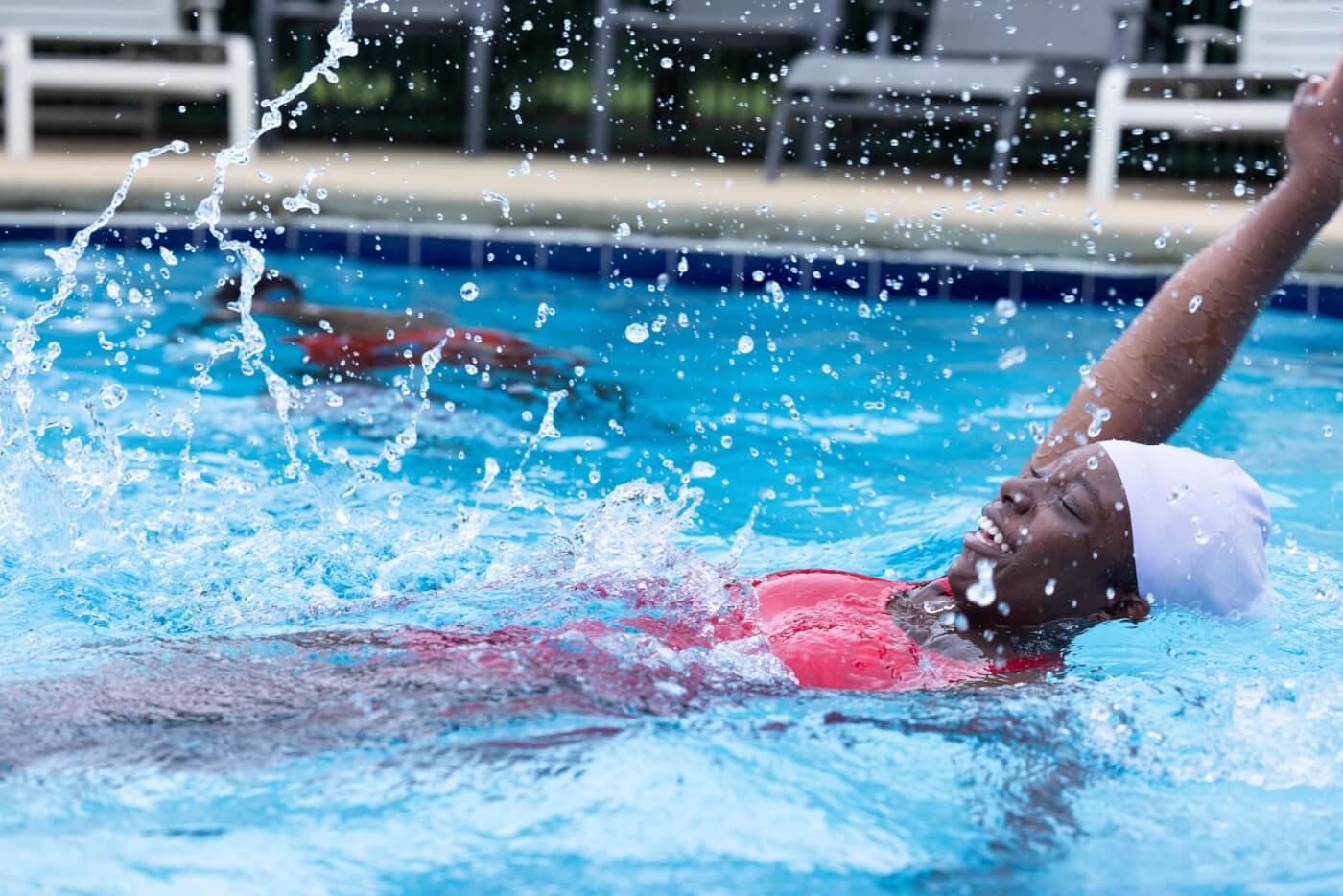
Outdoor Afro created its Making Waves program in response to the high number of Black children who drown each year, which is tied to the historic prohibition of Black people's access to beaches and public pools. This year, the not-for-profit will partner with U.S. swim providers to teach 3,000 kids and their caregivers how to swim. Photo courtesy of Outdoor Afro.
One of the reasons we’re together today is because Juneteenth is approaching. Juneteenth commemorates June 19, 1865, the date that 250,000 enslaved Black Americans in Galveston, Texas, were told they were free — two and a half years after the Emancipation Proclamation went into effect. What would you most want us to understand about the day?
First of all, my dad was from Texas and my mom was from Louisiana, so Juneteenth celebrations were a part of my upbringing. It was one of the many times of the year when family would gather, there’d be a big barbecue, and relatives who would help explain what it meant for our history. So I had a vernacular and practice for Juneteenth long before it became a national holiday.
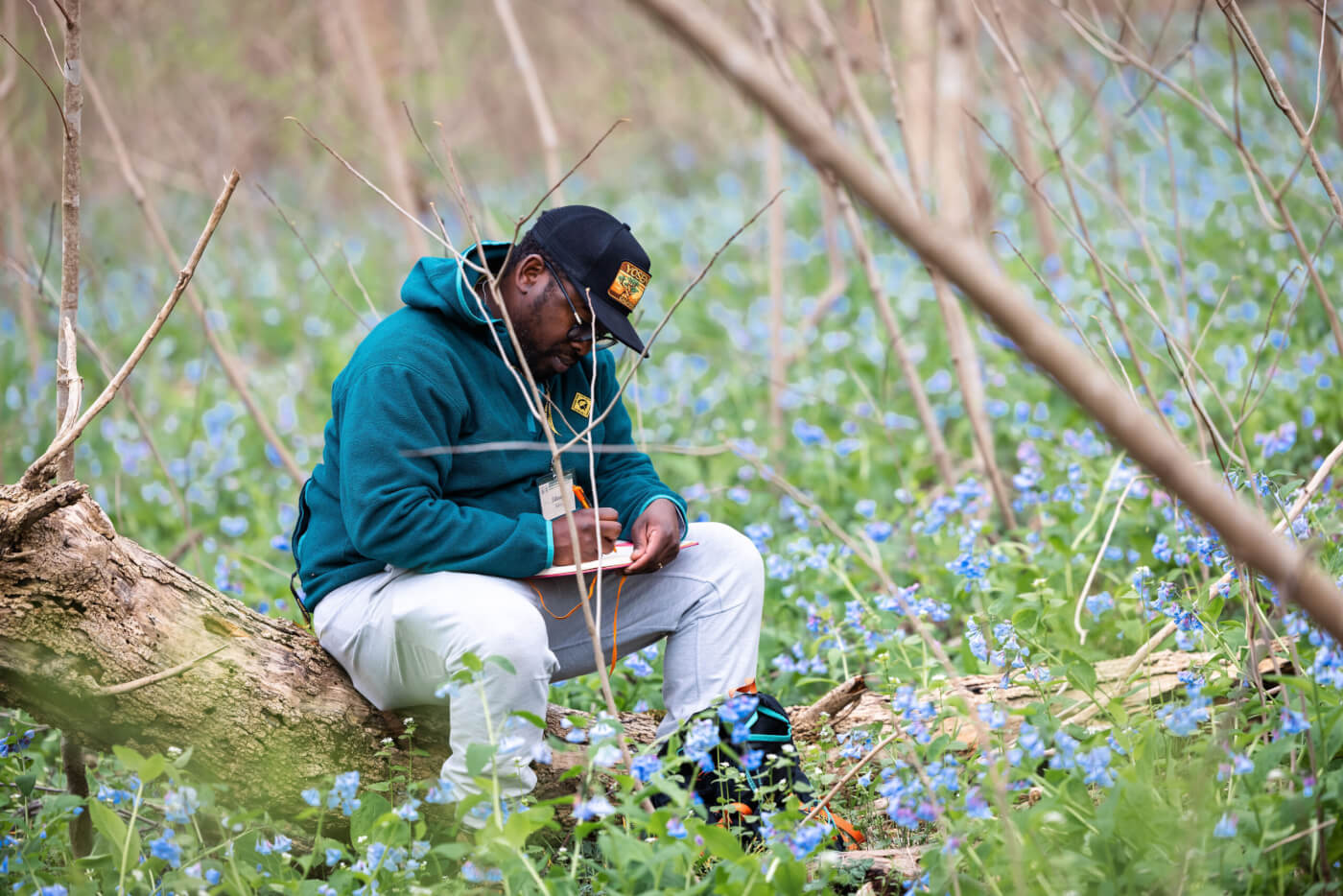
Annually for Juneteenth, Outdoor Afro asks U.S. communities to reconnect to that special place in the outdoors where they can reflect on what freedom means to them. Photo courtesy of Outdoor Afro.
In 2020, prior to the holiday designation, we decided as an organization to take Juneteenth as a moment that people could go out into nature and reflect for two and a half hours to represent the two and a half years that people in Galveston, Texas, didn’t know that they were actually free. It was a wonderful way for us to invite more people into the work because no matter who you are, in this country especially, everyone has something to say and reflect on what freedom means. We were really hoping that this would be not only a time to educate people on what Juneteenth is from a historical point of view, but also to get more people thinking about it in a way that is contemplative and about connectedness to nature. The first year we commemorated the day as an organization we decided to have people write down their reflections on freedom and send them to us so we could share them back out into the world. It was really powerful and beautiful what so many different people had to share.

This year, Outdoor Afro commemorates Juneteenth with the theme, “Freedom to Access Water,” an invitation to get outside, find a body of water in your community and reflect for two and a half hours — in honor of the two and a half years that freedom was delayed for the 250,000 enslaved Black people of Galveston, Texas. Illustration by Dajah Callen, courtesy of Outdoor Afro.
How is Outdoor Afro commemorating Juneteenth this year?
This year, we’re doing something similar to previous years — inviting people to take a moment on June 19 to reflect on the day and what freedom means to them. As an organization, we’re dedicated to strengthening family and community relationships with water, so our call to action for Juneteenth is to go outside, find a lake, river or pool in your neighborhood or your community, and spend two and a half hours there just reflecting on and honoring the two and a half years that freedom was delayed for the 250,000 enslaved Black people of Galveston, Texas.
From a staff perspective, we’ve seen how Juneteenth has gotten a little commercialized, so we’ll continue to amplify it on social media in the ways that we have, and invite people to participate. Yet we don’t want to make Juneteenth about us, at the end of the day. Our call to action is available through shared toolkits with our partners to help the public understand what it is and how they can participate — because there’s still some great education around it that everyone could benefit from learning.
What advice or tips do you have for other outdoor advocacy organizations, or any organization really, that’s commemorating Juneteenth?
There’s a solemnity to Juneteenth, but I think it can also hold the truth of the celebration of it too. Sometimes, people have trouble with that nuance — you know, it’s like, ‘Oh, we’re going to have Juneteenth cupcakes.” That doesn’t feel appropriate. But when I think about Juneteenth as a kind of a flavor, I think a lot about how we remember Martin Luther King’s birthday. How that day combines remembrance, joy and possibilities at the same time. How we can remember how far we’ve come and where we can continue to go to realize freedom and agency for everyone.
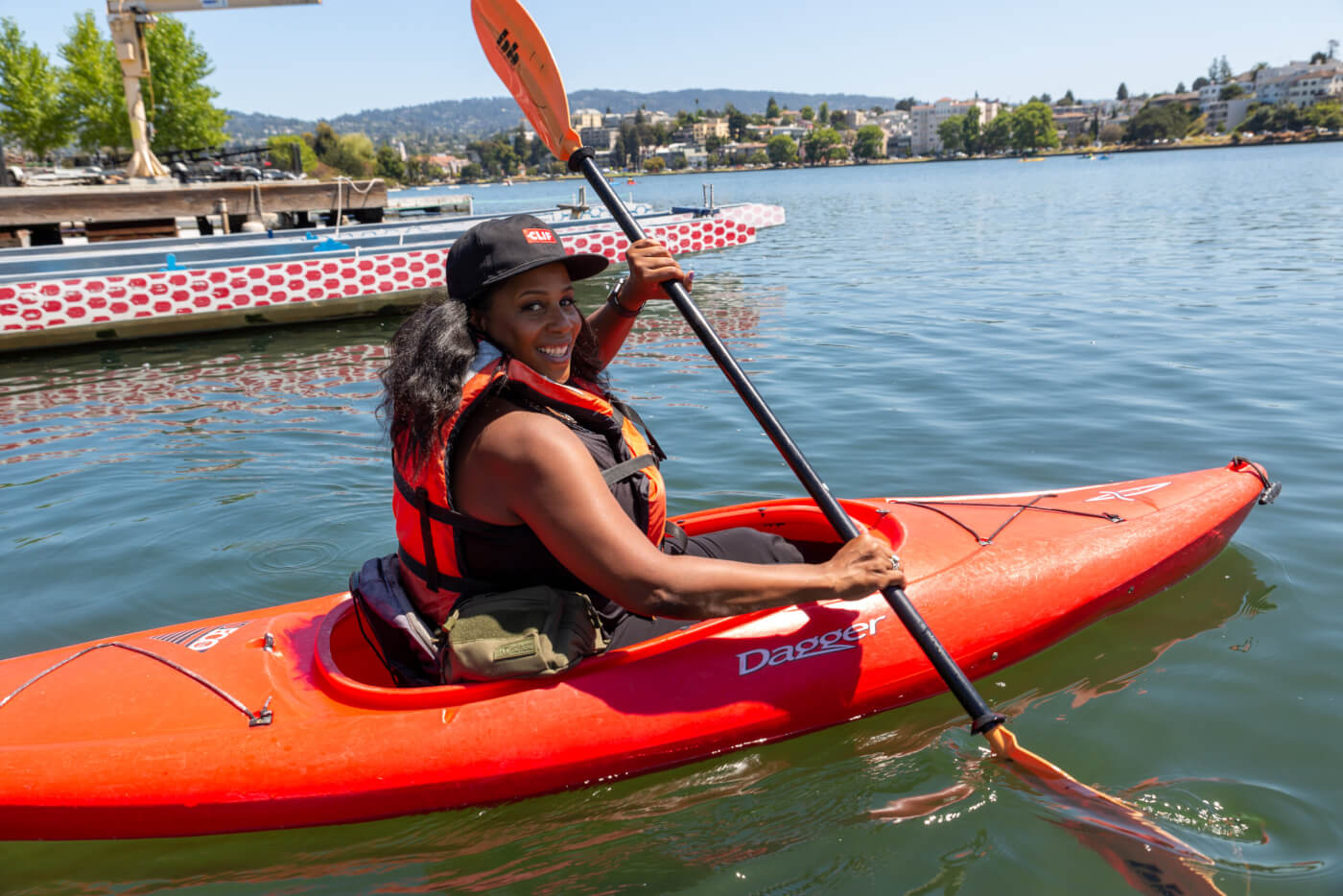
Rue Mapp enjoying a day on the water. Photo courtesy of Outdoor Afro.
I have to say, we’ve talked about so many things in this conversation, and through all of it you’ve focused so much on joy. What is the role of joy in your work and in your own outdoor life — how does that word come up so naturally for you?
A great question that brings a smile. I think that anybody can achieve joy. In my experience, joy is truly at hand when you feel connected to something that feels greater than who you are and to your ability to contribute positively and collectively to it. That’s what I feel nature is so uniquely able to provide for us. Without giving nature a job per se, it’s really this open source platform to tap into, and it is creation. I’m a Christian, and so nature is not the terminus of my belief, but a powerful artifact of infinite intelligence. I just never cease to marvel and reflect on what nature there is in me that I take everywhere I go, from the wind that was once rain to the same moon that regulates the tides regulating my body, that’s made up of mostly water. There’s just something really grounding and limitless about one’s connection to nature that, for me, highlights a belonging, purpose and connection that I feel we all could use, now more than ever. In a world that seemingly preoccupies itself with differences and conflict, I’m thankful there’s the warm refuge that nature experiences can provide for anyone.
Outdoor Afro: Juneteenth Commemoration and Toolkit
National Museum of African American History & Culture: The Historical Legacy of Juneteenth
Editorial: The True Meaning of Juneteenth
Nature photographer Dudley Edmondson has a vision for the representation of Black and Brown faces in the outdoors, a Finding Nature News story
The legacy and power of Black leadership in the outdoors, a Finding Nature News story
Improving diversity and representation in the outdoors, one photo at a time, a Finding Nature News story
-
Network News
POLICY UPDATE: Policy and advocacy for the children and nature movement
-
Voices
Binoculars, bald eagles and my journey as a Black birder
-
Richard Louv
THE WONDER BOWL: Ten Spring and Summer Nature Activities for Kids and Adults
-
Network News
Minneapolis Spotlight: The promise and possibilities of parks for youth
-
Voices
Why nature is my motherhood ally




